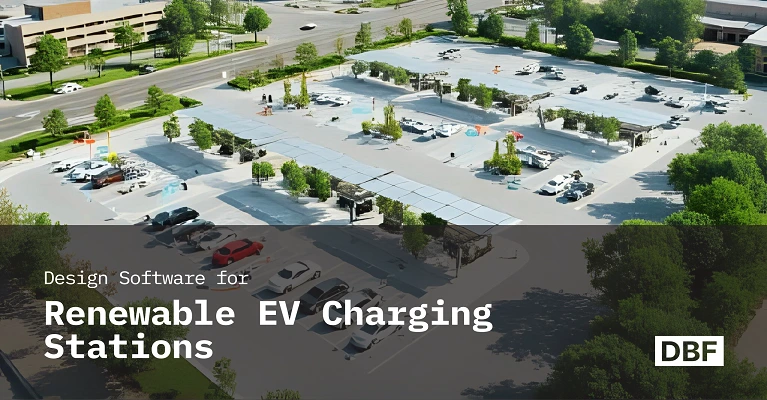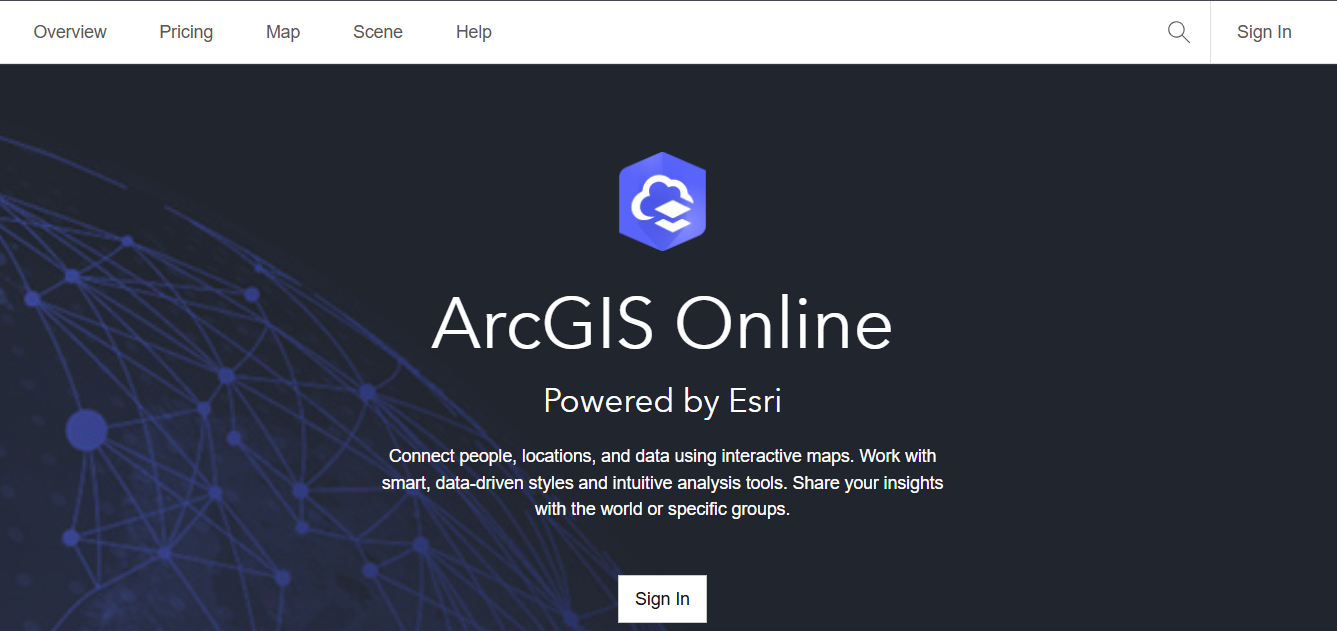
Design Software for Renewable EV Charging Stations
Design software for renewable EV charging stations integrates site planning, renewable energy modeling, grid compatibility, and scalability into one platform. Tools like Digital Blue Foam enable data-driven, GIS-based, and simulation-rich workflows, helping planners optimize solar, storage, and charging layouts, reduce costs, meet grid limits, and accelerate sustainable EV infrastructure deployment.

Electric-car sales continue to set records and public charging stations have leaped over 40 percent in 2023, with fast-charging units now making up more than a third of the world's stock (IEA, n.d.). Charging-station markets are predicted to explode from around USD 26 billion now to over USD 215 billion by 2032 - a tenfold surge that will put grids under pressure unless much of it is generated on-site through renewables (Takki, 2025; Akre, n.d.).
By 2025, industry surveys rank “energy-capacity constraints” as the single biggest worry for charge-point operators (Grzelewski, 2025). Without thoughtful planning, every new fast charger risks locking in more fossil-fuel peaker plants or overbuilding distribution hardware. The practical alternative is to bring renewables- on-site solar canopies, adjacent wind, battery storage- into the design from day one.
But installing thousands of high-power chargers into residential neighborhoods, highways and transport hubs, is no longer a straightforward layout process. It requires designers to balance daylight hours for rooftop PV, prevailing winds for micro-turbines, battery-storage cycles, grid-capacity maps, traffic demand, and permitting regulations - all prior to the first conduit being sketched.
That complexity is why a new generation of design software is coming online. Platforms like Digital Blue Foam (DBF) integrate live environmental information and generative modelling within a browser-based environment.
Thus, when used properly, design softwares turn renewable EV charging stations from a permitting nightmare into a climate-positive asset class, offering cities and developers a data-driven roadmap to grow infrastructure without growing emissions.
What Is Design Software for Renewable EV Charging Stations?
Simply put, design software for renewable EV charging stations is an end-to-end digital space that enables planners to transition from a blank site to a completely modelled, grid-aware, solar-ready charging hub.
In contrast with traditional CAD or BIM tools concentrating on drawing or documenting construction details, these platforms integrate three disciplines- Planning, Integration, and Monitoring- into one workspace:
- Planning involves testing dozens of locations against GIS layers for solar insolation, zoning setbacks, and traffic demand.
- Integration involves sizing rooftop photovoltaics, battery storage, and smart-grid hardware along with chargers to balance energy flows hour by hour.
- Monitoring involves simulating those flows over a typical year, alerting on voltage drop, peak-load penalty, and carbon savings before a single cable is laid.
The distinction from generic CAD/BIM is, thus, soon apparent:
- Live energy-flow simulation supplants static PowerPoint and spreadsheets.
- GIS-driven site scoring identifies plots where renewables can meet grid draw by 40 percent or more (NREL, 2025).
- Smart-charging algorithms simulate load shifting and vehicle-to-grid export, with compliance with new grid codes (gridX, n.d.).
Since the software can recognize both kilowatts and kerbs, it is at the center of "smart charging infrastructure" or systems that charge when renewable supply is plentiful, de-rate when the grid is under pressure, and even feed energy back during peak demand.
Digital Blue Foam is an example of this new genre: its browser-based engine overlays current solar and grid-capacity data in real time over generative arrangements, allowing designers to view instantly how a car-park canopy, a 500 kWh battery, and rapid DC chargers will perform when subjected to alternative tariffs or climatic conditions. The outcome is a planning process that is quicker, more data-filled, and ultimately greener than has ever before been achievable through traditional drafting software.
Key Features and Principles of EV Charging Software
Renewable-energy integration
The initial litmus test for any charging-design platform is the way it natively integrates clean generation into the design. Good tools read hourly solar irradiance, regional wind rises, and factor in shading obstructions to determine photovoltaic canopies or rooftop arrays' size prior to the reservation of a single kilowatt of grid supply. Paired Power's pop-up solar stations, for example, are able to offset five times the feeder availability when properly placed and angled, a statistic confirmed in software well before panels reach the site (evConnect, n.d.). Another example is that of Digital Blue Foam, which helps by operating real-time solar-radiation studies within its website so planners can simulate, for example, full parking areas and see the anticipated kilowatt-hours change in real-time.
Grid compatibility and storage modelling
Clean energy is merely half the story; the other half is preventing transformers and breakers from tripping as twenty cars charge simultaneously. New platforms take feeder-line ratings and time-of-use tariffs, and alternate through charge-discharge schedules to level peaks. The National Renewable Energy Laboratory's EVI-X suite demonstrates that intelligent scheduling can reduce substation upgrades by 35 percent when combined with on-site batteries (NREL, 2025). Ampcontrol's depot simulator confirms the same for fleets, estimating 30 percent energy-cost savings through algorithmic load shifting (Ampcontrol, n.d.).
Site suitability and GIS analysis
A bad parcel choice can ruin even the most intelligent hardware. Good software draws on national GIS layers- solar potential, land-use codes, traffic volumes, demographic demand- and scores all potential lots. A GIS–MCDM analysis of solar-assisted stations concluded that just 7 percent of parcels along the Ankara–Istanbul corridor satisfied combined sun-hour, zoning, and access requirements, reinforcing the necessity for automated screening (Hisoglu et al., 2025). North Carolina's EVSE Suitability Tool provides an analogous public workflow for U.S. counties (NC Clean Energy Technology Center, 2023).
Scalability and network optimization
Lastly, good software looks beyond one site. As fleets expand, operators require equipment that manages hundreds of chargers within cities, installs firmware, and redirects drivers when bays are occupied.
Industry studies indicate that intelligent energy management allows a site to have six times more chargers without feeder upgrades (Honig, 2025), and EVESCO adds that scalable back-ends avoid expensive rip-and-replace cycles as fleets swell (EVESCO, n.d.). Platforms like Monta already handle almost a million points, demonstrating that cloud architectures can span the world (Carey, 2024).
Digital Blue Foam fits into that trend by exporting optimized layouts straight into popular BIM environments, so city planners can scale up a winning solar-plus-storage blueprint to dozens of depots with little rework.
Top Design Software for Renewable EV Charging Stations
1. HOMER Pro (Hybrid Optimization of Multiple Energy Resources)

- Purpose: Optimizes the design of microgrids and hybrid renewable systems.
- Use Case: Simulates solar + battery + grid-powered EV stations.
- Key Features:
- Cost optimization of energy systems
- Load profiling
- Renewable integration
Best for: Feasibility studies, energy modeling
2. SketchUp + Sefaira (by Trimble)

- Purpose: 3D design + early-stage energy modeling.
- Use Case: Visualizing EV charging stations with solar panel layouts.
- Key Features:
- Conceptual 3D modeling
- Solar exposure analysis
- Wind and shading simulation
Best for: Architects and urban designers
3. AutoCAD Electrical
- Purpose: Electrical circuit design and automation layouts.
- Use Case: Planning charging infrastructure wiring, conduit paths, and load flow.
- Key Features:
- Symbol libraries for electrical components
- Power distribution schematics
- Automation system diagrams
Best for: Electrical engineers designing charging hardware networks
4. Helioscope

- Purpose: PV (solar) system design and energy yield estimation.
- Use Case: Designing rooftop or canopy-mounted solar arrays at EV stations.
- Key Features:
- Solar shading and loss modeling
- Performance simulations
- Rapid site modeling from satellite imagery
Best for: Solar designers and PV engineers
6. Revit + Dynamo (BIM)

- Purpose: Building information modeling for integrated design.
- Use Case: Collaborative planning of EV station structures, utilities, and civil works.
- Key Features:
- Parametric modeling
- MEP and structural coordination
- Site planning integration
Best for: AEC professionals and project teams
7. PV*SOL / PVsyst

- Purpose: Advanced simulation of photovoltaic systems.
- Use Case: Solar generation estimation for EV station energy supply.
- Key Features:
- Irradiation analysis
- Grid-tied and standalone modeling
Best for: Renewable energy consultants and EPC firms
8. ArcGIS CityEngine / QGIS

- Purpose: Geospatial planning and urban-scale energy deployment.
- Use Case: Finding optimal sites based on sun access, traffic, and zoning.
- Key Features:
- GIS-based solar potential mapping
- Urban planning visualization
Best for: City planners and sustainability consultants
9. MATLAB Simulink

- Purpose: Control system simulation and power electronics design.
- Use Case: Modeling inverter behavior, smart charging algorithms, and energy storage.
- Key Features:
- Real-time control simulation
- Renewable + EV systems co-design
Best for: R&D teams, academic projects
10. Digital Blue Foam (DBF)

- Purpose: AI-powered urban planning and sustainable design platform.
- Use Case: Site selection, environmental analysis, and sustainable massing for EV charging stations.
- Key Features:
- Climate and solar analysis
- AI-based site and zoning insights
- Sustainable design scenarios and performance scoring
Best for: Urban planners and architects designing context-sensitive, climate-responsive EV infrastructure
Unique Advantage with DBF:
- Quickly generate multiple site planning options that balance solar potential, accessibility, urban density, and walkability.
- Ideal for early-stage feasibility of public EV hubs or smart mobility corridors in cities.
Comparison Table: Design Software for Renewable EV Charging Stations
Strategies for Choosing EV Charging Station Designing Tools for Planners
Energy-flow modeling and load management are at the center of any feasible charging-hub design. Systems that integrate power-flow engines with real-time tariff tables allow designers to observe kilowatt-hours flow through panels, batteries, and feeders by the hour, showing designers when a site will surge above the transformer rating. An NREL survey of over 100 managed charging schemes identified that smart charge management can delay or scale back expensive grid upgrades by shaving peaks and shifting loads without inconveniencing drivers (NREL, 2025).
Scenario testing of peak demand and weather variability is the second line of defence. Recent machine learning research indicates that incorporating forecasts of traffic and weather can push prediction accuracy as high as 89 percent, reducing forecasting error by nearly half (EV Charging Forecasting Exploiting Traffic, Weather and User Information, 2025). By including those variables within stochastic runs- heat-wave afternoons, storm-cloud mornings, holiday traffic- design software prioritizes how each layout performs.
Selecting the correct parcel is equally important. GIS-based suitability software like North Carolina State University's EVSE Suitability Map sorts through thousands of potential lots and areas by layers of solar exposure, grid headroom, zoning, and equity metrics, winnowing down potential plots to as few as seven percent along high traffic corridors (NC Clean Energy Technology Center, 2023). DBF leverages the same open-data stacks- along with its own walk-time and heat-island layer- to educate sites on a score so that planners immediately visualize opportunity and risk.
Ultimately, a renewable-fit network will need to use smart grid language. Vehicle-to-grid (V2G) integration pipelines turn parked cars into dispersed batteries. Experts predict V2G to become a necessary grid-support solution in 2025 as mandates tighten and utility rates increase (Nuvve, n.d.). while China has already launched 30 city pilots to explore bidirectional charging at scale (Howe & Paul, 2025).
Design Challenges to Overcome
Renewable-powered charging promises are diluted by technical and institutional obstacles. Foremost among them is complexity: each project needs to balance solar irradiance profiles, feeder-line capacities, tariff schedules, battery degradation, and real-time traffic predictions. Managing that in spreadsheets alone is unrealistic; planners require engines that weave the variables together and bring conflicts to the surface early.
Digital Blue Foam addresses the problem by pulling grid-capacity maps, solar layers and demand models into one browser tab, but even a smart interface can only simplify- not eliminate- the underlying intricacy.
Capital expenditure and operating expenditure trade-offs introduce an additional source of friction. Stationary batteries and canopies, and high-powered chargers require significant up-front expenditures, but research indicates that co-location can release new revenue from price arbitrage and grid-services markets, cutting lifetime expenses in spite of the capex peak.
The International Energy Agency reports that economics for a site change significantly once batteries start shaving peak tariffs, compelling designers to model cash flows as meticulously as kilowatts (IEA, n.d.).
Regulation can stall even the most well-capitalized business case. In most jurisdictions, there are distinct permits for electrical work, renewable generation, and parking-lot modifications, typically subject to agencies that do not use common data standards.
Lastly, each station has to weigh user access against grid constraints. Placing hubs along congested corridors enhances utilisation but can overburden constrained feeders; relocating them to industrial peripheries reduces grid pressure but discourages uptake.
New York's own zero-emission targets tell of the conflict: the state doubled public chargers over three years, but experts caution that upgrades to distribution networks are running well behind. Solving the impasse requires software that can map walk-time catchment and transformer headroom onto a single map, exactly where next-generation platforms like DBF can shift the balance from gridlock to solution.
Conclusion
EV charging stations are spreading at record speed - more than 1.3 million public installations were put in place in 2024 alone, a 30 percent jump that now strains transformer capacities from Barcelona to New York (IEA, n.d.). Meeting this pace with clean energy instead of additional fossil peakers requires digital platforms that observe every kilowatt, canopy shade and tariff spike before breaking ground. The correct platform distills multi-disciplinary data into unambiguous decisions, reduces capex with accurate battery sizing, and stays in front of changing grid codes.
Digital Blue Foam already bundles those features in a browser tab, converting feasibility hours to minutes and exporting renewable-optimised layouts directly into BIM.
If your next charging hub must be grid-friendly, solar-rich, and future-proof, it's time to take the workflow for a spin.
Frequently Asked Questions
1. What is renewable EV charging design software?
It is a digital environment that assists planners in transitioning from an empty parcel to a fully designed, renewable-capable charging hub. Unlike conventional CAD or BIM software that focuses on geometry, the software overlays solar and wind information, and battery models, on the layout so that designers can simulate technical and financial performance prior to building.
Digital Blue Foam carries this integrated approach even further by pairing generative geometry with live environmental layers within the browser, reducing concept iterations from days to minutes.
2. Why integrate renewables at the station itself?
On-site solar or wind offsets grid draw during peak hours, trims lifetime operating costs, and shields operators from volatile electricity prices. Studies show that even a modest canopy array can cover 40 percent of a site’s annual energy and cut transformer upgrades in half.
3. How do simulations enhance planning precision?
Simulations of load-flow and weather variance expose the points where charger demand, cloud cover, and grid tariffs come into conflict. Revealing those pressure points in software, teams can resize batteries, optimize charge schedules, and skip the expensive last-minute redesigns.
4. Do I have to be a programming mastermind to work with DBF?
No. It is specially designed for architects, engineers, and planners who want to use drag-and-drop workflows. Environmental layers, tariff tables, and generative layout tools are pre-set up; users tweak sliders and parameters instead of scripts. For complex cases, DBF has enterprise integrations, but most renewable-charging studies can be done efficiently with its out-of-the-box interface.
References
AEC Magazine. (n.d.). Digital Blue Foam launches for sustainable building design. Digital Blue Foam launches for sustainable building design. https://aecmag.com/concept-design/digital-blue-foam-launches-for-sustainable-building-design/
Akre, S. (n.d.). Solar Powered EV Charging Station Market Size, Share & Report 2034. Market Research Future. https://www.marketresearchfuture.com/reports/solar-powered-ev-charging-station-market-35838
Ampcontrol. (n.d.). Simulation Tool for EV Charging Software. Ampcontrol. https://www.ampcontrol.io/simulation-tool
Carey, N. (2024, 10 29). Danish EV charger software firm Monta expands into US market. Danish EV charger software firm Monta expands into US market. https://www.reuters.com/technology/danish-ev-charger-software-firm-monta-expands-into-us-market-2024-10-29/
Circutor. (n.d.). Canopy project at the Barcelona-Catalonia Circuit - CIRCUTOR. Circutor. https://circutor.com/en/success-stories/canopy-project-at-the-barcelona-catalonia-circuit/
Digital Blue Foam. (n.d.). AI Generative Design. AI Generative Design. https://www.digitalbluefoam.com/feature-main-cat/ai-generative-design
Digital Blue Foam. (n.d.). AI Generative Design. AI Generative Design. https://www.digitalbluefoam.com/feature/ai-generative-design
Digital Blue Foam. (n.d.). 15 Minute City - Spatial Analytics | DBF. Digital Blue Foam. https://www.digitalbluefoam.com/feature-sub-cat/15-minute-city
Digital Blue Foam. (n.d.). Masterplanning. Masterplanning. https://www.digitalbluefoam.com/industries/masterplanning
Digital Blue Foam. (n.d.). Solar Radiation Simulation - Sun Studies - Sustainability First | DBF. Digital Blue Foam.
https://www.digitalbluefoam.com/feature/solar-radiation-simulation
Digital Blue Foam. (n.d.). Spatial Analytics. Digital Blue Foam. https://www.digitalbluefoam.com/feature-main-cat/spatial-analytics
Digital Blue Foam. (n.d.). Sustainability First | DBF. Digital Blue Foam. https://www.digitalbluefoam.com/feature-main-cat/sustainability-first
EV charging forecasting exploiting traffic, weather and user information. (2025, 4 30). International Journal of Machine Learning and Cybernetics. https://link.springer.com/article/10.1007/s13042-025-02643-8
evConnect. (n.d.). Paired Power Partners with EV Connect to Deliver Clean Energy to the City of Campbell’s First Electric Vehicle in its Fleet. evConnect. https://www.evconnect.com/news/paired-power-partners-with-ev-connect-to-deliver-ev-charging
Evesco. (n.d.). EV Charging Management Software - A Guide. EV Charging Management Software - A Guide. https://www.power-sonic.com/blog/ev-charging-management-software/
gridX. (n.d.). What is load management for EV charging – gridX. gridX. https://www.gridx.ai/knowledge/load-management-for-ev-charging
Grzelewski, J. (2025, May 22). Charge point operators are worried about the grid. Tech Brew. https://www.emergingtechbrew.com/stories/2025/05/22/ev-charge-point-operators-grid
Hisoglu, S., Comert, R., Antila, M., Aman, R., & Huavila, A. (2025, March). Towards solar-energy-assisted electric vehicle charging stations: A literature review on site selection with GIS and MCDM methods. Sustainable Energy Technologies and Assessments.
https://www.sciencedirect.com/science/article/pii/S2213138825000244
Honig, R. (2025, May 13). Scaling Smarter for EV Charging Networks: Insights from the 2025 State of EV Charging Network Operators Survey. Driivz. https://driivz.com/blog/scaling-smarter-for-ev-charging-networks-insights-from-the-2025-state-of-ev-charging-network-operators-survey/
Howe, C., & Paul, S. (2025, April 1). China to launch grid-connected car projects to balance power supply. Reuters. https://www.reuters.com/business/autos-transportation/china-launch-grid-connected-car-projects-balance-power-supply-2025-04-02/
IEA. (n.d.). Trends in electric vehicle charging – Global EV Outlook 2024 – Analysis. IEA. https://www.iea.org/reports/global-ev-outlook-2024/trends-in-electric-vehicle-charging
McKenzie, L., Di Filippo, J., & Sharpe, B. (n.d.). Supporting the EV Charging Network of the Future. Atlas Public Policy.
NC Clean Energy Technology Center. (2023, 2 27). Mapping Electric Vehicle Charging Station Site Suitability with New GIS Tool by NCCETC. Clean Transportation. https://nccleantech.ncsu.edu/2023/02/27/mapping-ev-charging-station-suitability/
NREL. (2025, March 5). EVI-X Modeling Suite of Electric Vehicle Charging Infrastructure Analysis Tools | Transportation and Mobility Research. NREL. https://www.nrel.gov/transportation/evi-x
Nuvve. (n.d.). 2025 U.S. Vehicle-to-Grid (V2G) Market Outlook. 2025 U.S. Vehicle-to-Grid (V2G) Market Outlook. https://nuvve.com/2025-u-s-vehicle-to-grid-v2g-market-outlook/
SP Group. (2025, 2 25). SP Group launches Tengah's First Public EV Chargers, Expanding Singapore's Green Mobility Network. SP Group. https://www.spgroup.com.sg/about-us/media-resources/news-and-media-releases/SP-Group-launches-Tengah-s-First-Public-EV-Chargers--Expanding-Singapore-s-Green-Mobility-Network
Takki, K. (2025, February 5). Global EV Charging Station Market Will Reach USD 215 Billion with CAGR OF 30.5% by 2032. Statzon. https://statzon.com/insights/global-electric-vehicle-charging-stations-market
Weijenberg, C. (n.d.). Digital Blue Foam. Digital Blue Foam. https://www.digitalbluefoam.com/features-overview/ai-generative-design



